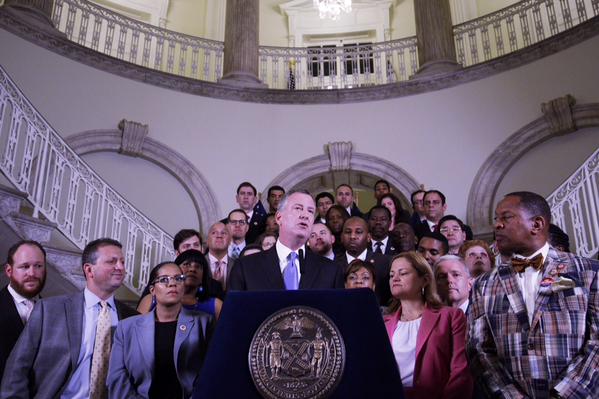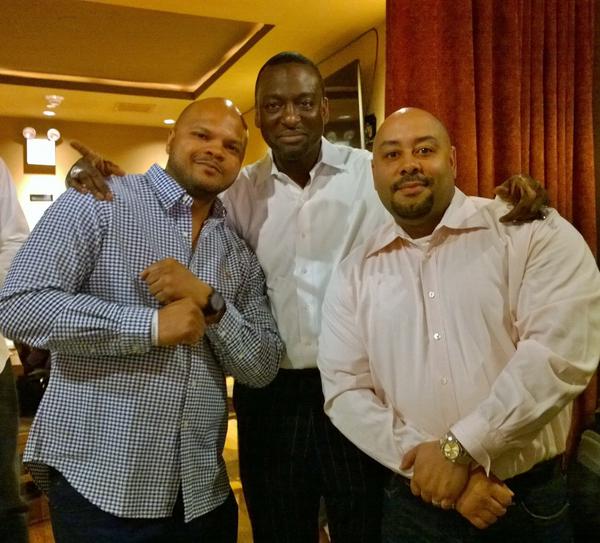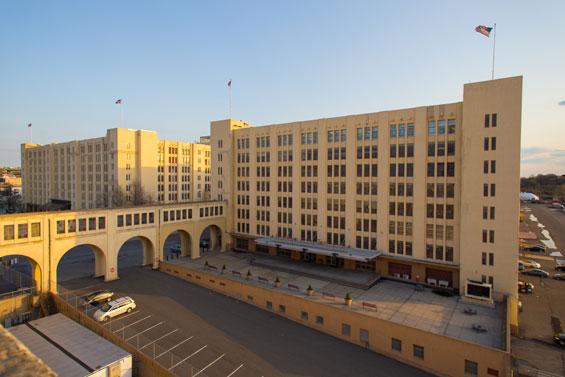A Budget Victory for NYC Military Veterans

Mayor de Blasio and Council members announce budget deal (photo: William Alatriste)
With almost half of Mayor Bill de Blasio's term in office complete, it has been well-documented that military veterans have seen a number of administration policies as perplexing and frustrating. What's made this all the more disappointing is that the mayor has unique insight into the difficulties veterans and their family members face through the experience of his own father, a World War II veteran who struggled when he came home.
As a result of the administration's decisions and the belief that we weren't being heard, my group (NY MetroVets) banded together with several other veterans groups to push for real progress. After months of testimony at hearings and engaging with local elected officials and the media - while keeping the veterans community informed and engaged - our hard work paid off in the city budget.
Late last week the City Council voted to adopt the New York City Fiscal Year 2016 budget. The spending plan, which starts July 1, contains an increase of almost $2.9 million dollars for veterans services.
This increase will double the Mayor's Office of Veterans Affairs (MOVA) budget and allow Commissioner Loree Sutton to not only hire additional staff but perhaps even address some veterans issues that are outside the mayor's strategic plan. It also puts money into the city's veterans homelessness-fighting initiative to assist the federal Departments of Veterans Affairs (VA) and Housing and Urban Development (HUD) on the final push to end veteran homelessness here in New York City.
Lastly, and quite significantly, the Council's veterans initiative was more than doubled with funding for organizations that will provide direct services (legal, health services, job placement, and support programs) for veterans and their family members.
All in all, while some may still be disappointed, this is a victory and there is much to be happy about.
To be clear, more could have been done for veterans. But, take stock at what has just been accomplished after much effort and what felt like a steep uphill climb. As an advocate for 20 years, I can say that the budget increases and commitment from city government have not happened on this scale in a very long time. The wins are especially important now as the country was at war over the last decade-plus. It also shows that with all the groups, non-profits, and others fighting for funding, we were able to have our community's voice heard and some of our needs directly addressed. Progress.
Are there still battles to be fought? Absolutely. This budget is a move in the right direction, but this increase can be expanded by the administration in future spending plans, with further prioritiaiton of veterans services. With the talk of a new city Department of Veterans Affairs tabled (for now) we will need to work with the city to see how we can get budgetary funding to our local veteran organizations - which are doing the work on the ground and in the community - faster than what the current process allows. Veterans and our allies will also need to watch what Commissioner Sutton does with her newly increased budget and we look forward to seeing where veterans fit into First Lady Chirlane McCray's mental health roadmap initiative.
With veterans still returning home from overseas, with those already here, and with many coming to New York City for economic opportunity, we look to the administration, through its policies and its agencies, to do even more to help veterans.
But today I thank Mayor de Blasio, Council Speaker Melissa Mark-Viverito, Council Members Eric Ulrich and Paul Vallone, and the rest of the Council's veterans committee for their work and acknowledgment of the challenges veterans face and attention we deserve. I encourage my fellow veterans to enjoy the moment, focus on tracking smart, helpful spending by our government, ready to access new and improved services, and prepare to begin the work all over again toward Fiscal Year 2017.
***
Joe Bello served 11 years in the U.S. Navy/Naval Reserve and has been a veterans advocate in New York City for two decades. He is the founder of NY MetroVets.
The Assembly Must Act to Prevent Wrongful Conviction

The author, Yusef Salaam, middle, & other members of the Central Park 5 (photo: @venusinorbit)
We were interrogated for over 30 hours. We were accused, threatened, lied to, unable to eat or drink. All of this culminated in severe physical and emotional exhaustion and eventually prompted some of us - teenagers at the time - to provide false confessions to the infamous attack of the Central Park jogger.
Almost none of this interrogation process was video-recorded. Instead, the jury saw video-snippets of what appeared to be damning confessions; not the hours of coercion or the details of the crime that police were feeding us and demanding that we include in the well-rehearsed video "confessions." Although I did not provide a signed or video-taped confession, the police and prosecution claimed that I had offered an admission implicating myself in the crime. I made no such statement, but because there was not video capturing our interrogations from start to finish, the truth was buried. The jury never saw what led to Raymond Santana, Kevin Richardson, Korey Wise and Antron McCray, all teenagers, to falsely confess on tape. And as a result all of us – the Central Park Five – were wrongfully convicted.
The system failed us, but now New York can enact simple and practical changes in police procedure to ensure that false confession does not result in additional wrongful convictions. Assembly Speaker Carl Heastie should use his leadership to pass A8157 out of his chamber. This bipartisan bill, which the Senate has already passed, would address two of the root causes of wrongful conviction in New York and nationally: false confession and misidentification. The bill would require police to video-record interrogations from start to finish and would provide law enforcement with the necessary training and resources to implement eyewitness identification practices that have been scientifically proven to protect against misidentification.
If the camera had been rolling throughout our interrogation, there might not have been the false confessions, and there would have been a record of the fact that I did not offer any "admission." But the phenomena of false confession leading to wrongful conviction is not limited to the Central Park Five; false confession played a role in almost half of New York's wrongful convictions that were proven by DNA evidence. In fact, false confessions or misidentification were contributing factors in nearly all of New York's 29 wrongful convictions that eventually resulted in DNA exonerations. And keep in mind that DNA exonerations only represent a small share of wrongful conviction cases. Physical evidence that can be subjected to DNA testing that can prove innocence is only available in a small percentage of cases, yet the contributing factors that led to the DNA exonerations – eyewitness misidentification, false confessions, etc. – are present in many cases.
In addition to protecting the innocent, A8157 would also strengthen public safety. The real perpetrator who raped the Central Park jogger, Matias Reyes, went on to commit three additional rapes and one murder. In New York's 29 DNA exonerations, 11 real perpetrators were identified. Five of those real perpetrators committed 11 additional violent crimes, which included three rapes, six murders and two other violent crimes.
With the legislative session in overtime, I implore Speaker Heastie and the Assembly to pass A8157. Lawmakers have a duty and a responsibility to ensure that no one else in our great state has to endure the horror of wrongful conviction.
***
Yusef Salaam is a member of the Central Park Five and was wrongfully convicted of rape and assault.
Certificate Programs Offer Opportunity for At-Risk Youth

Brooklyn Army Terminal (photo: @NYCEDC)
Today, there are many problems facing disadvantaged New Yorkers but one of the most pressing is the large share of youth who are not transitioning well. This is most apparent with black boys who experience a disproportionate share of suspensions and have low high school graduation rates. Indeed, in New York City, only 28 percent of black males complete high school on time. This weak school progress, however, is not limited to black boys and is so pervasive that New York City has initiated a number of alternative high schools attended by youth who are significant credits behind and often older than eighteen years of age. It is reflected in the almost 200,000 youths, 17 to 24 years old, who are neither in school nor in paid employment.
What can be done? City school chancellor Carmen Farina has instituted policy changes to dramatically reduce the number of school suspensions. As I wrote earlier this year, policies that reduce suspensions will not be very effective if they ignore an important source of anti-social behavior: often chaotic and sometimes abusive home environments. In another initiative, Farina announced that General Electric Corporation will provide funding to support Career and Technical Education (CTE) pilot programs at ten schools. CTE programs link high school coursework to community college occupational programs.
While CTE programs can be effective, certificate programs can be very beneficial for a large share of the most at-risk students. Certificates are recognition of completion of a course of study based on a specific field. They differ from industry-based certifications and licenses which typically involve passing an examination to prove a specific competency or completing an apprenticeship. By contrast, certificate programs take place entirely in the classroom.
A comprehensive report began, “In America, the postsecondary certificate has become a cost-effective tool for increasing postsecondary education attainment and gainful employment.” The survey involved pointed to studies that found certificates of at least one year provided a wage premium identical to Associate’s degrees—almost 40 percent for women and around 20 percent for men.
While the average certificate of less than one year has more limited value, this is not true in all cases. For example, police and protective services certificates are predominantly short-term and earned by men, but exceed the average 27 percent wage premium for male certificate holders. Certificates in business and office management are predominantly short-term and earned by women, but exceed the earnings of the median female certificate holder.
Nationally, public colleges award half of all certificates. However, in large cities where many at-risk students reside, public community colleges award only one-third of certificates; less than five percent in Washington, Baltimore, and Philadelphia. The extremes go from New York City, where community colleges award only 1.5 percent of certificates, to Chicago and Detroit, where two-thirds are awarded by the community colleges.
This evidence indicates that the CUNY system is an outlier and is ill-serving adolescents who are most at risk. CUNY’s neglect leaves many with no choice but to seek certificate programs in the for-profit sector. These schools have been demonized for their high failure rates and level of indebtedness many of their students experience. Yet they do have strengths that other institutions lack. The education sociologist James Rosenbaum suggests “that many for-profits have developed good counseling departments that help student not only with their academic goals, but also with their economic and social problems…They put resources into counselors and they’re much better at retaining students than community colleges.” A recent New York City study contends that the best for-profit schools offer real opportunity.
At-risk students too often must navigate the for-profit world after leaving school and many will make uninformed selections of schools and/or programs. Certainly, if the CUNY system would dramatically expand its certificate offerings this problem could be ameliorated. In addition, if high schools form partnerships with best-practice for-profits, at-risk students can be channeled into the best schools and the most appropriate programs. Given how valuable these links would be for the for-profits, high schools could negotiate very favorable conditions, enabling students to avoid high debt burdens while gaining valuable occupational skills.
For many educators, the ideal is academic learning – meaning a four-year college education – for all. Disadvantaged youth, however, may do better in the long run if we prioritize better and more immediate pathways into the labor market. At a time when 36 million American workers who attended college did not complete a degree, certificates are piecemeal, attainable, bite-size educational awards that can add substantially to postsecondary completion.




